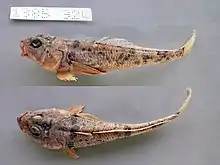Gobionotothen marionensis
Gobionotothen marionensis, the lobe-lip notothen, is a species of notothen native to the South Georgia and the South Sandwich Islands in the Atlantic Ocean, and the Crozet and Prince Edward Islands in the Indian Ocean.[1][2]
| Gobionotothen marionensis | |
|---|---|
 | |
| Dorsal and lateral view of a specimen from the Muséum National d'Histoire Naturelle (MNHN), France | |
| Scientific classification | |
| Kingdom: | |
| Phylum: | |
| Class: | |
| Order: | |
| Family: | |
| Genus: | |
| Species: | G. marionensis |
| Binomial name | |
| Gobionotothen marionensis Günther, 1880 | |
Etymology
The Latin word 'Gobio' literally means 'gudgeon', and the species name 'marionensis' refers to Marion Island, a bleak 20.9 km (13-mile)-long island in the Indian Ocean where this species was first discovered.[1]
Description
This species is a relatively small notothen, attaining a maximum length of 20 cm (7.9 inches). In alcohol, this species is generally colored grayish-brown, with four indistinct dark saddles on the back. The first saddle reaches the base of the pectoral fin. The rounded caudal fin has a dark bar present. When encountered in real life, the saddles are much more distinct and form tranverse bars which break up into spots on each side of the body. Dark spots and blotches are present around the head, fins and lateral part of the body (which are also present in specimens preserved in alcohol, but again, these are much less distinct than in real life). A series of small, dark spots is present on the pectoral fin rays, and a blackish spot is often present on the upper part of the fin's base.[2][1]
Ecology
This species inhabits shelf waters depths of 0-150 m (0-492 ft). It is a diurnal, benthopelagic predator that feeds on benthic invertebrates. Crustaceans, especially krill, mysids, isopods and amphipods, are the major component of the diet in the Atlantic Ocean, however, polychaetes are also consumed at South Georgia (generally consumed by individuals larger than 12 cm (4.7 inches) in total length). Specimems in the South Sandwich Islands feed almost exclusively on amphipods. Decapods and polychaetes form the main part of the diet at the Prince Edward Islands, where they compose 54% and 30 % of the diet respectively. When the fish reach 7 cm (2.8 inches) in total length, they become ambush predators. Pelagic prey is virtually absent from the diet.[2][1][3]
Known predators of this species include the dusky dolphin and the Antarctic fur seal.[4]
Commercial importance
This species is of no interest to commercial fisheries.[5]
References
- Miller, Richard Gordon (1993). A History and Atlas of the Fishes of the Antarctic Ocean. Nevada, USA: Foresta Institute. p. 792.
- Gon, Ofer; Heemstra, Phillip C. (1990). Fishes of the Southern Ocean. Grahamstown, South Africa: J.L.B. Smith Institute of Ichthyology. pp. 292–293.
- (In Polar Biology, June 2005) Pakhomov, Evgeny; Davis, Simon; Kaehler, S.; Kalinga, Robert M. Diet and daily ration of two nototheniid fish on the shelf of the sub-Antarctic Prince Edward Islands.
- "Predators - Gobionotothen marionensis". www.fishbase.se. Retrieved 2021-01-21.
- "Gobionotothen marionensis, Lobe-lip notothen". www.fishbase.se. Retrieved 2021-01-21.